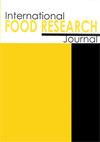Antioxidant capacity and sequence of peptides derived from oysters and green mussels in Vietnam
IF 1
4区 农林科学
Q4 FOOD SCIENCE & TECHNOLOGY
引用次数: 0
Abstract
High-nutrition components and antioxidant compounds have been discovered in many marine organisms in recent years, especially oysters and mussels; but, the two bivalves have not been studied extensively in Vietnam. Therefore, both oysters and green mussels from Long Son, Vietnam were collected for investigation. Results showed that the total macronutrient contents in green mussels were greater than those of oysters, with glutamic acid being the most abundant amino acid in both oysters and green mussels at 1.35 and 1.25 g/100 g, respectively. Total relevant mineral content was 521,954 mg/100 g in oyster flesh, while that in green mussels was 496,847 mg/100 g. Specifically, the zinc content was 30.30 mg/100 g in oysters, 21.96 times more than that in green mussels (1.38 mg/100 g). Biological mixtures of peptides were obtained through enzymatic hydrolysis, and their calculated catalytic efficiencies in oysters and green mussels were 0.051 and 0.067 mg/mL/s, respectively. The antioxidant activity of these peptides was determined by IC50 values in DPPH, with 6.39 mg/mL for oysters, and 10.4 mg/mL for green mussels, and IC50 values in ABTS with 18.0 mg/mL for oysters, and 18.3 mg/mL for green mussels. The sequences of the four most abundant peptide fractions in oyster and green mussel hydrolysates were identified by LC-MS; the two fractions identified in oysters were Asn-Lys-Gln-Ala (F1) and Val-Val-Val-Asp-Val-Gly-Ile (F2), and those in green mussels were Gly-Arg-Thr-Tyr (F3), and Pro-Thr-Gln-Val-Lys-Leu (F4). Tyrosine, a powerful nucleophile, was found in F3. As a result, it is reasonable to believe that green mussels have stronger ABTS free radical scavenging activity than oysters. These results will provide a real insight for research on antioxidant processes involving biological peptides from oysters and green mussels in Vietnam.越南牡蛎和青贻贝的抗氧化能力和肽序列
近年来,在许多海洋生物中发现了高营养成分和抗氧化化合物,特别是牡蛎和贻贝;但是,这两种双壳类动物在越南还没有被广泛研究过。因此,我们收集了越南龙山的牡蛎和青贻贝进行调查。结果表明,青贻贝的总常量营养素含量高于牡蛎,其中谷氨酸含量最高,分别为1.35 g/100 g和1.25 g/100 g。牡蛎肉中相关矿物质含量为521,954 mg/100 g,青贻贝中相关矿物质含量为496,847 mg/100 g。其中,牡蛎的锌含量为30.30 mg/100 g,是青贻贝(1.38 mg/100 g)的21.96倍。通过酶解得到多肽的生物混合物,其在牡蛎和青贻贝中的催化效率分别为0.051和0.067 mg/mL/s。DPPH(牡蛎为6.39 mg/mL,青贻贝为10.4 mg/mL)和ABTS(牡蛎为18.0 mg/mL,青贻贝为18.3 mg/mL)的IC50值测定了这些肽的抗氧化活性。用LC-MS对牡蛎和青贻贝水解物中最丰富的4个肽段进行了序列鉴定;牡蛎中鉴定出的两个组分分别为Asn-Lys-Gln-Ala (F1)和Val-Val-Val-Asp-Val-Gly-Ile (F2),青贻贝中鉴定出的两个组分分别为Gly-Arg-Thr-Tyr (F3)和pro - thr - gln - valys - leu (F4)。在F3中发现了强亲核试剂酪氨酸。因此,我们有理由认为青贻贝对ABTS自由基的清除能力强于牡蛎。这些结果将为越南牡蛎和青贻贝生物多肽抗氧化过程的研究提供真正的见解。
本文章由计算机程序翻译,如有差异,请以英文原文为准。
求助全文
约1分钟内获得全文
求助全文
来源期刊

international food research journal
Agricultural and Biological Sciences-Food Science
CiteScore
1.40
自引率
0.00%
发文量
75
期刊介绍:
The International Food Research Journal (IFRJ) publishes papers in English, six (6) issues a year with the coverage of:
Food Science and Technology
Nutrition and Dietetics
Agriculture, multidisciplinary
Chemistry, multidisciplinary
The scope of the Journal includes:
Food Science, Food Technology and Food Biotechnology
Product Development and Sensory Evaluation
Food Habits, Nutrition, and Health
Food Safety and Quality
Food Chemistry, Food Microbiology, Food Analysis and Testing
Food Engineering
Food Packaging
Food Waste Management
Food Entrepreneur
Food Regulatory
Post-Harvest Food Management
Food Supply Chain Management
Halal Food and Management
 求助内容:
求助内容: 应助结果提醒方式:
应助结果提醒方式:


